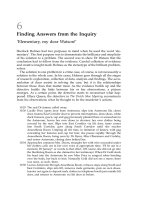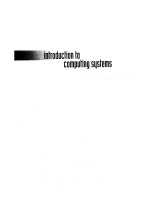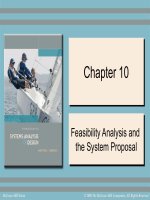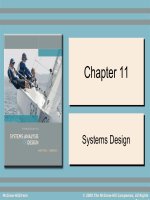Lecture Introduction to computing systems (2/e): Chapter 6 - Yale N. Patt, Sanjay J. Patel
Bạn đang xem bản rút gọn của tài liệu. Xem và tải ngay bản đầy đủ của tài liệu tại đây (338.81 KB, 31 trang )
Chapter 6
Programming
Copyright © The McGraw-Hill Companies, Inc. Permission required for reproduction or display.
Solving Problems using a Computer
Methodologies for creating computer programs
that perform a desired function.
Problem Solving
• How do we figure out what to tell the computer to do?
• Convert problem statement into algorithm,
using stepwise refinement.
• Convert algorithm into LC-2 machine instructions.
Debugging
• How do we figure out why it didn’t work?
• Examining registers and memory, setting breakpoints, etc.
Time spent on the first can reduce time spent on the second!
62
Copyright © The McGraw-Hill Companies, Inc. Permission required for reproduction or display.
Stepwise Refinement
Also known as systematic decomposition.
Start with problem statement:
“We wish to count the number of occurrences of a character
in a file. The character in question is to be input from
the keyboard; the result is to be displayed on the monitor.”
Decompose task into a few simpler subtasks.
Decompose each subtask into smaller subtasks,
and these into even smaller subtasks, etc....
until you get to the machine instruction level.
63
Copyright © The McGraw-Hill Companies, Inc. Permission required for reproduction or display.
Problem Statement
Because problem statements are written in English,
they are sometimes ambiguous and/or incomplete.
• Where is “file” located? How big is it, or how do I know
when I’ve reached the end?
• How should final count be printed? A decimal number?
• If the character is a letter, should I count both
upper-case and lower-case occurrences?
How do you resolve these issues?
• Ask the person who wants the problem solved, or
• Make a decision and document it.
64
Copyright © The McGraw-Hill Companies, Inc. Permission required for reproduction or display.
Three Basic Constructs
There are three basic ways to decompose a task:
Task
True
False
Test
condition
Subtask 1
Test
condition
True
Subtask 2
Sequential
Subtask 1
Subtask 2
Subtask
Conditional
Iterative
65
False
Copyright © The McGraw-Hill Companies, Inc. Permission required for reproduction or display.
Sequential
Do Subtask 1 to completion,
then do Subtask 2 to completion, etc.
Get character
input from
keyboard
Count and print the
occurrences of a
character in a file
Examine file and
count the number
of characters that
match
Print number
to the screen
66
Copyright © The McGraw-Hill Companies, Inc. Permission required for reproduction or display.
Conditional
If condition is true, do Subtask 1;
else, do Subtask 2.
True
Test character.
If match, increment
counter.
file char
= input?
Count = Count + 1
67
False
Copyright © The McGraw-Hill Companies, Inc. Permission required for reproduction or display.
Iterative
Do Subtask over and over,
as long as the test condition is true.
Check each element of
the file and count the
characters that match.
more chars
to check?
False
True
Check next char and
count if matches.
68
Copyright © The McGraw-Hill Companies, Inc. Permission required for reproduction or display.
Problem Solving Skills
Learn to convert problem statement
into step-by-step description of subtasks.
• Like a puzzle, or a “word problem” from grammar school math.
What is the starting state of the system?
What is the desired ending state?
How do we move from one state to another?
• Recognize English words that correlate to three basic
constructs:
“do A then do B” sequential
“if G, then do H” conditional
“for each X, do Y” iterative
“do Z until W” iterative
69
Copyright © The McGraw-Hill Companies, Inc. Permission required for reproduction or display.
LC-2 Control Instructions
How do we use LC-2 instructions to encode
the three basic constructs?
Sequential
• Instructions naturally flow from one to the next,
so no special instruction needed to go
from one sequential subtask to the next.
Conditional and Iterative
• Create code that converts condition into N, Z, or P.
Example:
Condition: “Is R0 = R1?”
Code: Subtract R1 from R0; if equal, Z bit will be set.
• Then use BR instruction to transfer control to the proper
subtask.
610
Copyright © The McGraw-Hill Companies, Inc. Permission required for reproduction or display.
Code for Conditional
Exact bits depend
on condition
being tested
True
Test
Condition
Subtask 1
Instruction
A
False
Last 9 bits of
address C
Generate
Condition
B 0000
?
C
Subtask 1
Subtask 2
0000 111
D
C
Subtask 2
Next
Subtask
Unconditional branch
to Next Subtask
Assuming all addresses are on the same page.
D
Next
Subtask
611
Last 9 bits of
address D
Copyright © The McGraw-Hill Companies, Inc. Permission required for reproduction or display.
Code for Iteration
Exact bits depend
on condition
being tested
Test
Condition
Instruction
A
False
Generate
Condition
0000
True
?
C
B
Subtask
Subtask
0000 111
C
Next
Subtask
Last 9 bits of
address C
Next
Subtask
Unconditional branch
to retest condition
Assuming all addresses are on the same page.
A
Last 9 bits of
address A
612
Copyright © The McGraw-Hill Companies, Inc. Permission required for reproduction or display.
Example: Counting Characters
A
START
Initialize: Put initial values
into all locations that will be
needed to carry out this
task.
- Input a character.
- Set up a pointer to the first
location of the file that will
be scanned.
- Get the first character from
the file.
- Zero the register that holds
the count.
Input a character. Then
scan a file, counting
occurrences of that
character. Finally, display
on the monitor the number
of occurrences of the
character (up to 9).
B
STOP
C
Initial refinement: Big task into
three sequential subtasks.
START
Scan the file, location by
location, incrementing the
counter if the character
matches.
Display the count on the
monitor.
STOP
613
Copyright © The McGraw-Hill Companies, Inc. Permission required for reproduction or display.
Refining B
B
Yes
B
Scan the file, location by
location, incrementing the
counter if the character
matches.
B1
Done?
No
Test character. If a match,
increment counter. Get next
character.
Refining B into iterative construct.
614
Copyright © The McGraw-Hill Companies, Inc. Permission required for reproduction or display.
Refining B1
Yes
B
Yes
B1
Done?
No
Test character. If a match,
increment counter. Get next
character.
Done?
No
B1
B2 Test character. If matches,
increment counter.
B3 Get next character.
Refining B1 into sequential subtasks.
615
Copyright © The McGraw-Hill Companies, Inc. Permission required for reproduction or display.
Refining B2 and B3
Yes
Done?
No
B2
Yes
Yes
Done?
No
R1 = R0?
R2 = R2 + 1
B1
B2 Test character. If matches,
increment counter.
B3
B3 Get next character.
R3 = R3 + 1
R1 = M[R3]
Conditional (B2) and sequential (B3).
Use of LC-2 registers and instructions.
616
No
Copyright © The McGraw-Hill Companies, Inc. Permission required for reproduction or display.
The Last Step: LC-2 Instructions
Use comments to separate into modules and
to document your code.
Yes
Done?
No
B2
Yes
R1 = R0?
R2 = R2 + 1
B3
R3 = R3 + 1
No
; Look at each char in file.
0001100001111100 ; is R1 = EOT?
0000010xxxxxxxxx ; if so, exit loop
; Check for match with R0.
1001001001111111 ; R1 = -char
0001001001100001
0001001000000001 ; R1 = R0 – char
0000101xxxxxxxxx ; no match, skip incr
0001010010100001 ; R2 = R2 + 1
; Incr file ptr and get next char
0001011011100001 ; R3 = R3 + 1
0110001011000000 ; R1 = M[R3]
R1 = M[R3]
Don’t know
address bits until
all the code is done
617
Copyright © The McGraw-Hill Companies, Inc. Permission required for reproduction or display.
Debugging
You’ve written your program and it doesn’t work.
Now what?
What do you do when you’re lost in a city?
Drive around randomly and hope you find it?
Return to a known point and look at a map?
In debugging, the equivalent to looking at a map
is tracing your program.
• Examine the sequence of instructions being executed.
• Keep track of results being produced.
• Compare result from each instruction to the expected result.
618
Copyright © The McGraw-Hill Companies, Inc. Permission required for reproduction or display.
Debugging Operations
Any debugging environment should provide means to:
1.
2.
3.
4.
Display values in memory and registers.
Deposit values in memory and registers.
Execute instruction sequence in a program.
Stop execution when desired.
Different programming levels offer different tools.
•
•
High-level languages (C, Java, ...)
usually have source-code debugging tools.
For debugging at the machine instruction level:
simulators
operating system “monitor” tools
in-circuit emulators (ICE)
– plug-in hardware replacements that give
instruction-level control
619
Copyright © The McGraw-Hill Companies, Inc. Permission required for reproduction or display.
LC-2 Simulator
execute
instruction
sequences
stop execution,
set breakpoints
set/display
registers
and memory
620
Copyright © The McGraw-Hill Companies, Inc. Permission required for reproduction or display.
Types of Errors
Syntax Errors
• You made a typing error that resulted in an illegal operation.
• Not usually an issue with machine language,
because almost any bit pattern corresponds to
some legal instruction.
• In high-level languages, these are often caught during the
translation from language to machine code.
Logic Errors
• Your program is legal, but wrong, so
the results don’t match the problem statement.
• Trace the program to see what’s really happening and
determine how to get the proper behavior.
Data Errors
• Input data is different than what you expected.
• Test the program with a wide variety of inputs.
621
Copyright © The McGraw-Hill Companies, Inc. Permission required for reproduction or display.
Tracing the Program
Execute the program one piece at a time,
examining register and memory to see results at each step.
Single-Stepping
• Execute one instruction at a time.
• Tedious, but useful to help you verify each step of your program.
Breakpoints
• Tell the simulator to stop executing when it reaches
a specific instruction.
• Check overall results at specific points in the program.
Lets you quickly execute sequences to get a
high-level overview of the execution behavior.
Quickly execute sequences that your believe are correct.
Watchpoints
• Tell the simulator to stop when a register or memory location changes
or when it equals a specific value.
• Useful when you don’t know where or when a value is changed.
622
Copyright © The McGraw-Hill Companies, Inc. Permission required for reproduction or display.
Example 1: Multiply
This program is supposed to multiply the two unsigned
integers in R4 and R5.
clear R2
add R4 to R2
decrement R5
No
R5 = 0?
Yes
HALT
x3200
x3201
x3202
x3203
x3204
0101010010100000
0001010010000100
0001101101111111
0000011000000001
1111111100100101
Set R4 = 10, R5 =3.
Run program.
Result: R2 = 40, not 30.
623
Copyright © The McGraw-Hill Companies, Inc. Permission required for reproduction or display.
Debugging the Multiply Program
PC
PC and registers
at the beginning
of each instruction
R2
R4
R5
Single-stepping
Breakpoint at branch (x3203)
x3200
--
10
3
x3201
0
10
3
x3202
10
10
3
PC
x3203
10
10
2
x3203
10
10
2
x3201
10
10
2
x3203
20
10
1
x3202
20
10
2
x3203
30
10
0
x3203
20
10
1
x3203
40
10
-1
x3201
20
10
1
40
10
-1
x3202
30
10
1
x3203
30
10
0
x3201
30
10
0
x3202
40
10
0
x3203
40
10
-1
x3204
40
10
-1
40
10
-1
R2
R4
R5
Should stop looping here!
Executing loop one time too many.
Branch at x3203 should be based
on Z bit only, not Z and P.
624
Copyright © The McGraw-Hill Companies, Inc. Permission required for reproduction or display.
Example 2: Summing an Array of Numbers
This program is supposed to sum the numbers
stored in 10 locations beginning with x3100,
leaving the result in R1.
R1 = 0
R4 = 10
R2 = x3100
R1 = R1 + M[R2]
R2 = R2 + 1
R4 = R4 - 1
No
R4 = 0?
Yes
HALT
x3000
x3001
x3002
x3003
x3004
x3005
x3006
x3007
x3008
x3009
0101001001100000
0101100100100000
0001100100101010
0010010100000000
0110011010000000
0001010010100001
0001001001000011
0001100100111111
0000001000000100
1111000000100101
625









